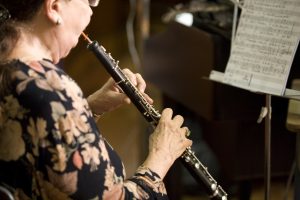History and Information
The oboe first appeared in the mid-17th century, developed from an older instrument known as a shawm. It is a double-reed instrument, so called because it has two reed segments that vibrate against each other to produce sound (rather than a single reed against a mouthpiece). The modern oboe is usually made out of wood and metal keys, and consists of 6 parts (the bell, the long joint, the boot, the wing joint, the bocal/crook, and the reed). It is the highest member of its family of instruments, which also includes the cor anglais (English horn) and the oboe d’amore. There is an extensive repertoire of music for the oboe, not only in the classical genre but also jazz, folk, and pop music.
When to Start
We recommend that students start oboe lessons around age 10 or 11. Younger students may not have developed the lung capacity or strength of facial muscles required to play the instrument. We encourage these students to start on a different woodwind instrument (such as the clarinet or flute), and then switch to the bassoon when they are physically able. Additionally, private lessons are STRONGLY recommended when first starting out on the oboe, as producing a quality sound requires some very specific techniques.
Getting an Oboe
There are many brands and models of oboe available for rent and purchase. For very young students, it is recommended to rent instruments for two reasons: 1) they will most likely grow out of instruments quickly and 2) they may lose interest (although we hope they don’t!). Please be advised that you must purchase reeds, or make them yourself. Most places that rent instruments will also provide repair services for their instruments. We can give you recommendations for places near you to buy or rent your oboe. Please contact us, and be sure to include your location!
Books and Supplies
Most rented oboes will come with items such as a case and cleaning implements. Your instructor can tell you which books and other supplies are appropriate, especially which type of reeds you should purchase. Most books and many supplies, including reeds, are available online. We can recommend stores near you where you can purchase supplies and music, if you prefer to do so in person. Please contact us, and again, remember to tell us where you live!
**Feel free to contact us with any questions you may have. We can help provide you with additional resources.**

